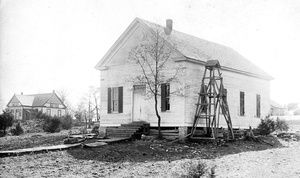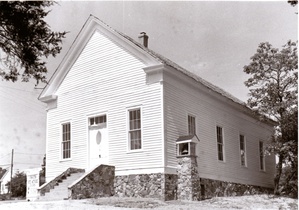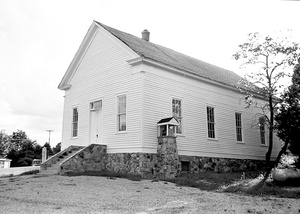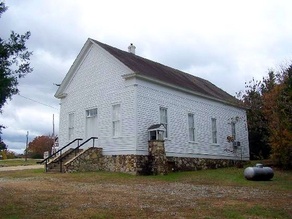In the 1850s, a Methodist Episcopal Church, South congregation organized in Powhatan. Earliest records of the congregation appear in1853 when the Arkansas Conference appointed Thomas B. Hillburn as the circuit preacher, but some sources say it was in existence as early as 1850 or 1854.[1] By 1859, the Powhatan Circuit had one hundred and eighty one white members, forty-nine white members on probation, thirteen colored members and five local preachers.[2] Circuit preachers continue to be appointed through 1873 when Powhatan became a station, a location that housed a permanent worship building.[3] The circuit was combined with Pocahontas this year as well with W.M. Watson as residing preacher.
 Powhatan United Methodist Church Circa 19th CenturyThe current church building was constructed circa 1874 or shortly thereafter. The warranty deed recording the John A. Lindsay family’s donation of the property to the Methodist Church in July of that year does not mention any buildings on the land.[4] Previous to the building of the this structure, Lawrence County court records indicate that in April 1870, court was held “in the church house in the town of Powhatan,” but it does not specify a location or which denomination.[5] On February 25, 1875, at approximately 4:30am, a fire broke out in H.T. Wickersham’s tin shop located in the rear section of the first floor of the building located in Lot Six of Block Three where the current brick Commercial Building stands today. This fire consumed the entire building and the surrounding blocks. Located within the tin shop’s building on the second floor were at least two rooms; the Masonic Lodge occupying one and the meetinghouse of the Presbyterian congregation in the other.[6] On March 8, 1875, the will of Mary E. Morrison, the widow of the prosperous Powhatan businessman James Morrison was written with the clause that one thousand dollars will be divided upon her death between the Presbyterian and Methodist churches with the purpose of building a church.[7] The fact that this was written two weeks after the fire gives credence that the Methodist congregation shared worshipping space with the Presbyterian congregation, a common practice in towns found on the itinerant circuits of both denominations.[8]
Powhatan United Methodist Church Circa 19th CenturyThe current church building was constructed circa 1874 or shortly thereafter. The warranty deed recording the John A. Lindsay family’s donation of the property to the Methodist Church in July of that year does not mention any buildings on the land.[4] Previous to the building of the this structure, Lawrence County court records indicate that in April 1870, court was held “in the church house in the town of Powhatan,” but it does not specify a location or which denomination.[5] On February 25, 1875, at approximately 4:30am, a fire broke out in H.T. Wickersham’s tin shop located in the rear section of the first floor of the building located in Lot Six of Block Three where the current brick Commercial Building stands today. This fire consumed the entire building and the surrounding blocks. Located within the tin shop’s building on the second floor were at least two rooms; the Masonic Lodge occupying one and the meetinghouse of the Presbyterian congregation in the other.[6] On March 8, 1875, the will of Mary E. Morrison, the widow of the prosperous Powhatan businessman James Morrison was written with the clause that one thousand dollars will be divided upon her death between the Presbyterian and Methodist churches with the purpose of building a church.[7] The fact that this was written two weeks after the fire gives credence that the Methodist congregation shared worshipping space with the Presbyterian congregation, a common practice in towns found on the itinerant circuits of both denominations.[8]
The Methodist Church building was in continuous use since it was built. On July 2, 1900, J.N. Beakley, the Administrator of John A. Lindsay’s estate, gives the rest of Block Seventeen to F.C. Stuart, Trustee of the Methodist Episcopal Church adding room for a churchyard.[9] Throughout the late nineteenth and early twentieth centuries, records exist reflecting Methodist preachers officiating weddings in Powhatan, presumably in the church.[10]
Methodism’s surge westward across the United States in the nineteenth century accompanied a growing commitment to overseas missions. In 1819, Methodist missionary societies were organized in eastern seaboard cities in response to the success of John Stewart, a missionary to the Wyandotte Indians of Ohio and founder of the first Methodist mission in America.[11] The General Conference of 1820 formally adopted the constitution of the Missionary Society of the Methodist Episcopal Church and ten years later it lent support to a foreign mission in Liberia created in the 1820s by the American Colonization Society.[12] Missionary work quickly spread from Africa to South America and into the Far East, but inadequate organization and resources, and lack of worldly experience limited their impact. To help improve their influence, auxiliary societies formed as early as 1819 by Methodist women culminated in 1869 with the establishment of the Woman’s Foreign Missionary Society of the Methodist Episcopal Church.[13]
Social changes created by the American Civil War, and new mission opportunities allowed women to support other women in ways impossible in their male-dominated home churches and brought about the feminization of missions in the last third of the nineteenth century. Married women supported educated single women traveling as teachers, doctors, social reformers, and evangelists with the purpose to Christianize and civilize foreign populations, raising the lowly status of women.[14] At one point, the Powhatan United Methodist Church had an active Methodist Missionary Society, educating local women about missions and raising money to spread the gospel.[15]
The increased urbanization of the country, especially in the South, which occurred during the latter half of the nineteenth century facilitated the organization of women’s groups allowing their expression of social usefulness, self-reliance and initiative.[16] Many Methodist churches in the area organized Ladies’ Aid Clubs and Temperance Societies.[17] These types of societies were instrumental in the temperance movement and agitated for the passage of Prohibition as well as campaigning for prison reform, the establishment of industrial schools for girls, and homes for underage offenders.[18] Through their clubs, members kept up up-to-date with current events and mobilized public opinion. In 1928, a Quarterly Conference of the Paragould District was held in the church.[19]
In the 1940s, the congregation split over doctrinal disagreements. Members of the congregation left to form the Powhatan Pentecostal Church formerly located on Lindsay Drive across from the park boat ramp. The leaving members removed the ventilation fan and one of the chandeliers to install in their church building. Although separate, members from each congregation would attend each church’s services. [20]
The church has changed names twice, in keeping with the larger Methodist organization in Arkansas. In 1939, the Powhatan congregation became the Powhatan Methodist Episcopal Church, after the Methodist Episcopal Church, South merged with the Methodist Episcopal Church and the Methodist Protestant Church.[21] In 1968, the title again changed to Powhatan United Methodist Church, after another merger with the Evangelical United Brethren.[22]
On December 17, 1976, the National Park Service admitted the church building to the National Register of Historic Places.[23] (Figure 6) Eight years later in 1984, a Grant-In-Aid Covenant between the Arkansas Historic Preservation Program and the Church Board of Trustees represented by Robert L. Flippo created a Historic Preservation Easement, allowing the church to receive a ten thousand dollar grant from the Arkansas Historic Preservation Program to preserve and restore the property, including repairing the foundation, windows, doors, siding, and paint.[24] The foundation was reworked; the existing concrete block piers replaced by a rock and concrete apron around the bottom of the church. New concrete steps with flagstone sidewalls replaced the front WPA-era steps, and the re-enforcement of the building’s back elevation resulting in siding replacement using boards salvaged from the First Presbyterian Church in Black Rock, Arkansas, dating to the same approximate time period. The United Methodist Church Insurance Trust gave two thousand dollars to help replace the wiring in the church building.[25] In 1996, the church received another five thousand dollar from the Arkansas Historic Preservation Program for interior and exterior restoration, to fix water damage, and replace and repaint the northern foundation sill boards.[26] Iron powder-coated handrails were added to the front steps in 2006.[27]
 Powhatan United Methodist Church Circa 1976
Powhatan United Methodist Church Circa 1976 Powhatan United Methodist Church Circa 1986
Powhatan United Methodist Church Circa 1986 Powhatan United Methodist Church Circa 2016
Powhatan United Methodist Church Circa 2016
Information regarding the building's architecture.
[1] 1853 date comes from Mauzel Beal, The United Methodist Church Commission On Archives and History Appointments: North Arkansas Conference, White River Conference, Arkansas Conference 1820-1990, Vol. 1, Copied From Journals, 30; 1858 date comes from: “Powhatan Church placed on register of historically significant sites,” Times Dispatch (Walnut Ridge), 15 December 1977; 1850 date comes from Vernon, Methodism in Arkansas, 448; 1854 date comes from Darlene Moore, “Powhatan United Methodist Church” in Mother of Counties: Lawrence County, Arkansas (Paducah, Kentucky: Turner Publishing Company, 2001), 48.
[2] Minutes of the Annual Conference of the Methodist Episcopal Church, South 1858 to 1865, 180.
[3] Beal, 58.
[4] Warranty Deed from John A. Lindsay, et al. to Champ T. Stuart, et al., Trustees of the Methodist Episcopal Church, South, 14 July 1874, Lawrence County Deed Book Q, 465-466.
[5] “Powhatan Church,” Times Dispatch, 15 December 1977; Lawrence County Court Records, April 1870, Book F, page 313. Circuit Clerk’s Office, Walnut Ridge, Arkansas.
[6] Arkansas Gazette, March 2, 1875, pg. 1
[7] NEARA Probate files, Mary E. Morrison
[8] Nancy Britton, Two Centuries of Methodism in Arkansas 1800-2000 (Little Rock Arkansas: August House, 2000), 32; Bret E. Carroll, The Routledge Historical Atlas of Religion in American (New York: Routledge, 2000), 62; S. Charles Bolton, Arkansas, 1800-1860: Remote and Restless (Fayetteville: University of Arkansas Press, 1998), 111.
[9] Lawrence County Circuit Clerk, Lawrence County Land Deed Book 42, Lawrence County Courthouse: County Circuit Clerk Office, Walnut Ridge, Arkansas: 113.
[10] Various marriage records, MSNE.0013, Northeast Arkansas Regional Archives, Powhatan, Arkansas.
[11] David Hempton, Methodism: Empire of the Spirit, New ed. (Ann Arbor: Yale University Press, 2006), 157; “Stewart, John (1786-1823) Founder of the First Permanent Methodist Episcopal Mission Among the American Indians,” Boston University School of Theology: History of Missiology, accessed November 28, 2016, http://www.bu.edu/missiology/missionary-biography/r-s/stewart-john-1786-1823/.
[12] David Hempton, Methodism: Empire of the Spirit, 157.
[13] David Hempton, Methodism: Empire of the Spirit, 159.
[14] David Hempton, Methodism: Empire of the Spirit, 159; Martha H. Swain, The New Encyclopedia of Southern Culture, Volume 13: Gender (Chapel Hill: University of North Carolina Press, 2009), s.v. “Clubs and Voluntary Organizations.”
[15] “Powhatan Church,” Times Dispatch, 15 December 1977.
[16] Swain, “Clubs and Voluntary Organizations.”
[17] “Ladies Aid Society” folder, MSNE.0039, Methodist Episcopal Church, South (Portia) collection,
[18] Swain, “Clubs and Voluntary Organizations.”
[19] “Powhatan Church,” Times Dispatch, 15 December 1977.
[20] Per conversation with Darlene Moore, February 22, 2017.
[21] Britton, Two Centuries of Methodism, 213-318.
[22] Britton, Two Centuries of Methodism, 264-266.
[23] “National Register of Historic Places Application,” Arkansas Historic Preservation Program: National Register Listings, accessed October 28, 2016, http://www.arkansaspreservation.com/National-Register-Listings/PDF/LW0024.nr.pdf.
[24] Grant-in-Aid Covenant between Robert L. Flippo, Chairman of the Board of Trustees of the Powhatan United Methodist Church and the Arkansas Historic Preservation Program, 20 January 1984, Deed Book D-72, page 561-563. Circuit Clerk’s Office, Walnut Ridge, Arkansas.
[25] Information for the Bishop.
[26] Joia Burton, Arkansas Historic Preservation Program Grants Administrator, conversation with Park Interpreter Mary Buchman, 31 October 2014. She got this information from the Arkansas Historic Preservation Program database, but they no longer have paper files related to these grants; Per conversation with Darlene Moore on February 22, 2017. Darlene and her husband, Tom, were in charge of the Church’s 1984 to 2006 restorations.
[27] Per conversation with Darlene Moore on February 22, 2017.


